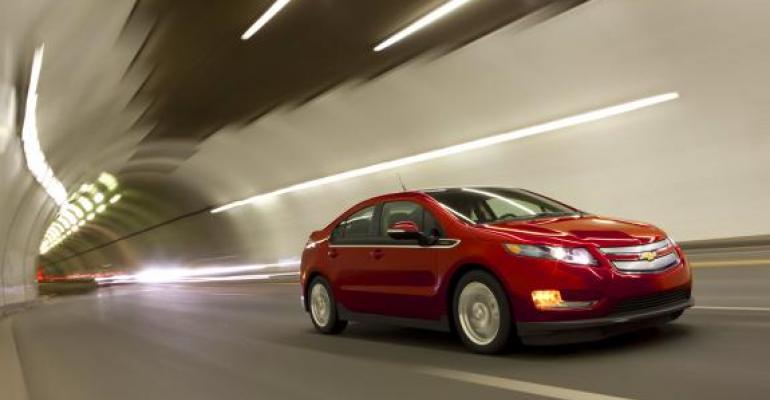Jim Jordan seems like a smart guy. A U.S. Congressman from Ohio, he holds a bachelor’s degree in economics and also a master’s degree.
However, Jordan apparently struggles with that troublesome concept known as connect-the-dots.
Most of us mastered this in kindergarten. Carefully drawing a continuous line from one numbered speck to the next produces a whimsical sketch of a turtle or bunny.
But by connecting dots that don’t connect, Jordan has managed to paint the National Highway Traffic Safety Admin. as the bogeyman.
As chairman of the U.S. Regulatory Affairs Subcommittee, Jordan presided this week over a public inquiry. The topic: NHTSA’s investigation of fires linked to the Chevrolet Volt’s battery technology.
The first fire was reported June 6, 2011. An official probe was launched just over five months later, on Nov. 25. It concluded Jan. 20, having revealed “no discernible defect trend,” NHTSA Administrator David Strickland testifies.
On the surface, this chronology suggests NHTSA failed to dot its i’s and cross its t’s.
“You wait six months before you start an investigation, and two weeks after you start an investigation, the secretary says it’s fine, and you think that’s normal?” Jordan asks Strickland, according to a New York Times account. (Note: The formal investigation actually lasted eight weeks.)
The blaze, which occurred on a NHTSA contractor’s property in Wisconsin, engulfed three other vehicles. But the first order of business in such cases is to determine whether or not the fire is a crime scene.
This was done by a local fire marshal. The conclusion: no arson. However, the fire’s cause remained unknown.
One month earlier, the Volt in question had been subjected to NHTSA’s side-impact crash test. It passed, receiving the agency’s highest rating.
In a curious rush to judgment, Jordan (who also boasts a law degree) suggests the evidence at this point was clear: the fire was linked to the earlier test. Case closed. Lock GM up and throw away the key.
However, NHTSA is in the habit – to the irritation of today’s fast-moving auto industry – of conducting painstaking inquiries. Some might also call this prudent.
Then, along with the contractor and representatives from General Motors, the agency conducted a forensic inspection of the suspect vehicle, which included a battery teardown.
The August investigation revealed the battery’s cooling system had been ruptured and the resulting leak caused a short that ignited.
That increased the total number of such incidents to, well, one. So …
“Once the Volt battery was identified as the source of the fire, NHTSA proceeded to determine whether the fire resulting from the May crash test was an anomaly,” Strickland testifies.
This task was undertaken even though there had been no real-world incidents of the variety that occurred at the Wisconsin storage site. (What’s the problem here, Jimbo?)
Another Volt was crash-tested in September. No battery-compartment intrusion. No coolant leak. No short-circuit. And no fire. Not even three weeks later.
GM conducted its own test with the same result.
Still not content, NHTSA called in the big guns – the U.S. Dept. of Defense. And with military-style gusto, NHTSA in November abused Volt battery packs until one began to smoke and emit sparks. But no fire was observed. A second battery pack caught fire one week later.
“The agency rarely opens a defect investigation without data from real-world incidents,” Strickland testifies. Yet, this was done.
Meanwhile, GM took the additional step of designing a collar to further protect the battery compartment. It currently is equipping Volts accordingly.
NHTSA crash-tested one such vehicle Dec. 22 and then monitored it for three weeks.
“We confirmed there was no intrusion into the battery compartment, no leakage of coolant and no post-impact fire,” Strickland tells Jordan’s subcommittee.
Does the investigation’s two-month duration indicate NHTSA was somehow influenced, as Jordan and his fellow critics suggest, by the legacy of the Obama Admin.’s GM bailout in 2009? (By the way, that move also saved hundreds of thousands of American jobs.)
A quick check of the agency’s recent defect investigations suggests, not surprisingly, that every case is different.
A fuel-leak investigation involving TDI versions of the VW Jetta, Golf and Audi A3 was concluded Dec. 2, 2011 after just four months. But NHTSA spent 21months examining tail-light failures involving BMW 3-Series models in a probe that ended Sept. 28, 2011.
Notably, both of those investigations prompted recalls. Does that suggest NHTSA has been told to keep its mitts off GM because the U.S. Treasury Dept. maintains an ownership stake in the auto maker?
A WardsAuto analysis of NHTSA records show GM was subject to more vehicle-recall campaigns (21) than any other auto maker in 2011.
And before naysayers cite that record as evidence Washington’s intervention was a waste, consider the number of Hondas and Toyotas implicated by recalls last year. The perennial quality leaders were on the hook for vehicle tallies of 14.7 million and 13 million, respectively. GM’s total: 455,901.
Against this backdrop, there is angst within NHTSA over the Volt flap. An impassioned insider tells me the political innuendo flung at the agency demeans the integrity of its engineers, who are more accustomed to being slammed for excessiveness.
“We are a safety agency,” I am told, as the pitch of the insider’s voice pleads for just appraisal.
Sometimes it doesn’t matter what picture emerges when you connect all the dots. People will see what they want to see.




